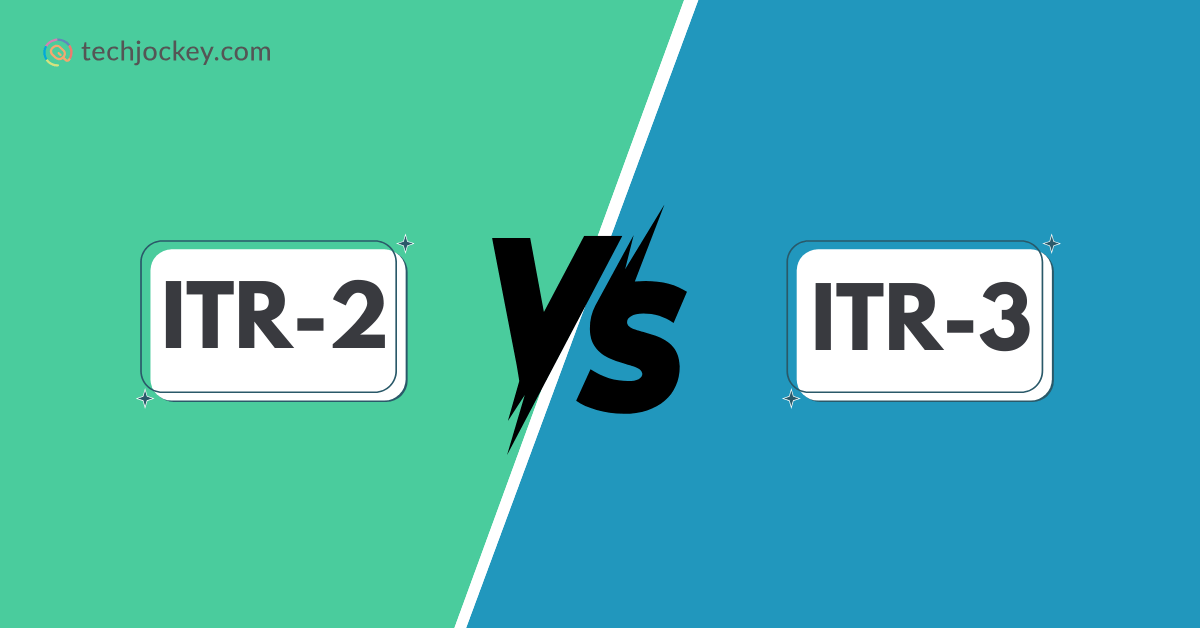
Taxpayers frequently experience confusion in selecting the form when they are filing an Income Tax Return in India. Of all the ITR types, the ITR-2 and ITR-3 are the most common ones, and individuals, and Hindu Undivided Families (HUFs) use them.
They may appear to be the same at first, but these have important differences in terms of eligibility, income sources covered, and filing requirements. Using the wrong ITR form may result in notices, or rejection or penalties, and it is important to know the difference.
In this blog, we are going to discuss ITR-2 vs ITR-3 and who should file each, their main features and a comparison between the two so that you can decide on the right form to file in your case.
ITR-2 is applicable to individuals and HUFs without business and profession income. That is, it applies to taxpayers who have their sources of income as:
ITR-2 is suitable in the case of salaried people, professionals whose earned income is not considered as a business, and those whose investments yield capital gains.
Example: In case you are a salaried employee and you have several house properties, dividends, and share selling profits, you are expected to file ITR-2.
Suggested Read: How to File ITR-2: Step by Step Guide
ITR-3 is aimed at individuals and HUFs earning from business or profession. This consists of proprietorship businesses and professional income both. It also addresses other sources of income, just like ITR-2.
Eligible income categories under ITR-3:
Example: If you run a consultancy firm, do intraday trading, or freelance as a software developer, you should file ITR-3.
Suggested Read: How to File ITR-3: Step by Step Guide
Both forms ITR-2 vs ITR-3 are for individuals and HUFs. But the main difference is in business/professional income. Let’s have a look at a detailed comparison.
Eligibility
Income Sources Covered
Intraday Trading & Speculative Income
Nature of Filing
Presumptive Taxation
| Criteria | ITR-2 | ITR-3 |
|---|---|---|
| Applicable To | Individuals & HUFs without business/professional income | Individuals & HUFs with business/professional income |
| Salary/Pension | Yes | Yes |
| House Property | Yes (single/multiple) | Yes (single/multiple) |
| Capital Gains | Yes | Yes |
| Other Income (interest, lottery, etc.) | Yes | Yes |
| Intraday Trading/Derivatives | Not allowed | Allowed |
| Presumptive Taxation | No | Yes |
| Complexity | Simple | Detailed with financial statements |
The following are examples to get a better understanding.
Case 1: Rohan is a professional earning a salary and two flats in terms of rent and investments in stocks as capital gains. He should file ITR-2.
Case 2: Priya is a freelance graphic designer with a source of income obtained through her clients as well as dividends and mutual fund returns. She is supposed to submit ITR-3 since she has professional income.
Case 3: Arjun is an intraday trader who gets speculative income in addition to his salary. He is supposed to submit ITR-3 because the trading is assumed to be business income.
Although the forms are different, the basic documents needed are similar
ITR-2 and ITR-3 are both submitted on the income tax e-filing portal. Here’s how:
In case you submit ITR-3, then you might be required to attach balance sheets and profit and loss accounts, which makes it a bit harder than ITR-2.
Filing your return under the wrong form can lead to:
This is the reason why it is important to know the difference between ITR-2 vs. ITR-3 before filing.
Final Thoughts
In the case of ITR-2 vs ITR-3, the decision will depend on the source of income. ITR-2 is your thing in case you are a salaried individual whose income is through house property or capital gains, among other investments.
However, ITR-3 would be required in case of any business, professional, or trading income. It is important to study your sources of income and then file. In case of doubts, hire a tax professional or use reliable income tax software to prevent errors.
Submission of the right form not only offers compliance but also enables you to maximize deductions, and unnecessary notice is avoided.
ITR-2 applies to individuals/HUFs who are not engaged in business/professional income (including trading, freelancing, etc.), whereas ITR-3 applies to those having an income of business/professional income (including trading, freelancing, etc.)
Derivatives and intraday trading should be reported under ITR-3 because they are business income.
ITR-2 applies to salaried people, pensioners and investors with capital gains as well as multiple house properties. And ITR-3 is for professionals, freelancers, proprietors and traders having business/professional income.
Today's digital economy means single weak password can indeed be catastrophic for any business.… Read More
Artificial intelligence is growing so fast and will grow and grow more faster in the… Read More
Online shopping is changing fast. With the advent of AI assistants, in fact, the way… Read More
Did you know cyberattacks hit business every 39 seconds? That’s right. Every minute counts… Read More
Hackers can’t just keep away by using strong passwords. Here’s the proof: Research says that… Read More
There’s new contender in the smart browser race. A few months after the launch… Read More